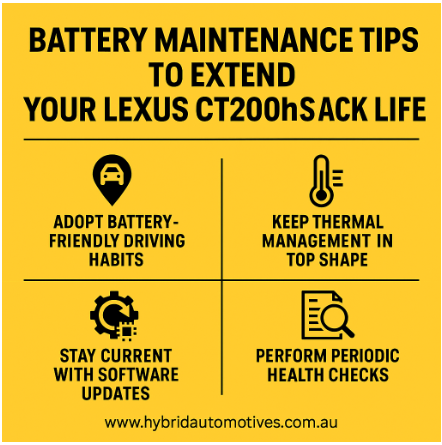Your Lexus CT200h’s hybrid battery pack is the heart of its efficiency and performance. While Toyota’s NiMH battery packs are built to last, proper maintenance can add years to their service life and help you avoid expensive replacements. This guide shares practical tips—from daily driving habits to periodic inspections—that any CT200h owner can apply to protect their investment and maximize fuel economy.

2. Understanding Your Lexus CT200h Hybrid Battery Pack
Before diving into maintenance, it helps to know what you’re working with:
- Pack Architecture:
The CT200h uses a high-voltage NiMH battery pack composed of 28 modules (each module contains six cells in series). Together, they deliver around 6.5 Ah of capacity at roughly 201.6 V nominal. - Battery Management System (BMS):
An onboard computer continuously monitors cell voltages, temperatures, and state-of-charge (SOC) to optimize pack health and performance. - Key Components:
- Cooling System: An electric fan circulates air over the pack; coolant lines (in later models) help maintain stable temperatures.
- HV Cabling & Service Plugs: High-voltage cables deliver pack power; service plugs allow safe access for DIY voltage checks.
- Sensors: Voltage and temperature sensors at each end of the pack feed data to the BMS for balancing and protection.
3. Adopt Battery-Friendly Driving Habits
Smooth, moderate driving can significantly reduce stress on your pack:
- Gentle Acceleration & Braking:
Avoid hard launches that draw high current from the pack. Instead, feather the accelerator and use regenerative braking smoothly to recharge cells gradually. - Maintain Moderate Cruise Speeds:
Sustained highway speeds often force the gasoline engine to power the car, limiting electric-assist opportunities. Staying at or slightly below posted limits maximizes hybrid assist and reduces battery cycling. - Prevent Deep-Discharge Cycles:
Don’t let the SOC drop to near zero in EV mode. If the battery gets very low, switch to hybrid mode (engine + battery) to top up the pack before the next stop.
4. Keep Your Thermal Management in Top Shape
Temperature extremes accelerate battery wear. Here’s how to safeguard your pack’s cooling system:
- Inspect & Replace Coolant on Schedule:
Toyota typically recommends changing hybrid cooling fluid every 100,000 km or 5 years. Check the level in the expansion tank and top up only with Toyota-approved coolant. - Ensure Proper Airflow & Fan Operation:
Clear leaves, dirt, and debris from the pack vents under the rear seat or cargo area. Listen for fan noise—if it’s louder or slower than usual, have it tested. - Park Smart:
In hot weather, park in shade or a garage to minimize heat soak. In freezing conditions, shelter the car if possible; NiMH batteries lose capacity in subzero temperatures.
5. Stay Current with Software & Firmware Updates
Toyota occasionally issues service bulletins and software updates that refine BMS logic:
- Check for TSBs:
Ask your dealer if any Technical Service Bulletins apply to the CT200h’s hybrid-control software. Updates can adjust charging algorithms and improve cell balancing. - Benefits of Calibration:
Updated firmware often includes enhanced temperature compensation and SOC estimation, helping your pack age more gracefully.
6. Perform Periodic At-Home Health Checks
Regular DIY inspections can catch issues early:
- Visual Inspection:
- Look under the rear seat for signs of coolant leakage or corrosion on module terminals.
- Check high-voltage cabling for frayed insulation or loose connectors.
- Basic Voltage Spot-Checks:
- With the service plug removed and a good quality multimeter, measure voltage at each of the two pack terminals.
- A spread of more than 0.1 V under no-load conditions suggests imbalance; consider professional balancing if the difference exceeds 0.2 V.
- OBD-II Scan & Data Logging:
- Use an OBD-II scanner that supports hybrid codes to pull P0A80–P0A8F faults (battery pack issues).
- Record live data such as pack voltage, individual module voltages, and temperature readings over a short drive to spot anomalies.
7. Mind Environmental & Storage Conditions
How and where you leave your car affects pack health over time:
- Minimize Temperature Extremes:
Park in covered or shaded areas in summer; in winter, use a garage or carport if available. - Long-Term Storage Tips:
If storing the CT200h for weeks or months, charge the battery to around 50–60% SOC (typically “B” on the dashboard gauge), then start and run the hybrid system every 2–3 weeks for 10–15 minutes to let the BMS perform self-tests.
8. When to Seek Professional Inspection
Some checks require specialized tools and training:
- Service Intervals:
Even with DIY checks, schedule a full professional hybrid-battery inspection every 60,000 km or every 3–4 years. - Workshop Tests:
Experts will perform controlled capacity tests, thermal imaging scans, and module-level cell balancing. - Red-Flag Symptoms:
Persistent “Check Hybrid System” warnings, sudden drops in electric-assist range, or erratic CELs warrant immediate shop attention.
9. Common Mistakes to Avoid
Protect your pack by steering clear of these pitfalls:
- Skipping Cooling-System Maintenance:
Old or contaminated coolant can’t regulate temperature effectively, accelerating wear. - Ignoring Dashboard Warnings:
“Check Hybrid System” lights are early alarms—dismiss them at your own risk. - Overloading the Vehicle:
Excessive weight (roof racks, heavy cargo) forces the battery and engine to work harder. - Aftermarket Mods:
Non-OEM chips or performance tunes can confuse the BMS and disrupt balanced charging.
